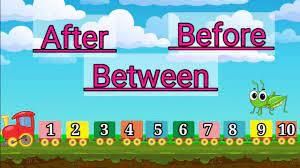Before, After, Between number (1-100) | Maths for UKG PDF Download
Hello there, young learners! Welcome to the exciting world of numbers. In this chapter, we're going to dive into the concepts of numbers that come before, after, and between other numbers. It's going to be fun, and by the end, you'll be a pro at figuring these out!

Before Numbers
Before we start, let's understand what "before" means. Imagine you are waiting in line to ride a roller coaster, and there are kids in front of you. The kids in front are "before" you. It's the same with numbers!
Examples
Example 1: What number comes before 5?
Ans: The number before 5 is 4.
Example 2: What number comes before 12?
Ans: The number before 12 is 11.
After Numbers
Now, let's talk about "after." If you're in the same roller coaster line, the kids behind you are "after" you. Similarly, in the world of numbers, "after" means the numbers that come next.
Examples
Example 1: What number comes after 7?
Ans: The number after 7 is 8.
Example 2: What number comes after 20?
Ans: The number after 20 is 21.
Between Numbers
Now, let's explore the concept of numbers that are "between" two other numbers. Imagine you have two friends, and they stand on either side of you. The friend on your right is like a smaller number, and the friend on your left is like a bigger number. The number in the middle is between them!
Examples
Example 1: What number is between 9 and 11?
Ans: The number between 9 and 11 is 10.
Example 6: What number is between 25 and 27?
Ans: The number between 25 and 27 is 26.
Great job, young mathematicians! You've just learned how to find numbers that come before, after, and between other numbers. Remember, "before" is like the kids in front, "after" is like the kids behind, and "between" is like standing with friends on both sides.
|
44 videos|179 docs|5 tests
|
FAQs on Before, After, Between number (1-100) - Maths for UKG
| 1. What are numbers before numbers? |  |
| 2. What are numbers after numbers? |  |
| 3. What are numbers between numbers? |  |
| 4. How can I determine the numbers before a specific number? |  |
| 5. How can I determine the numbers after a specific number? |  |
















